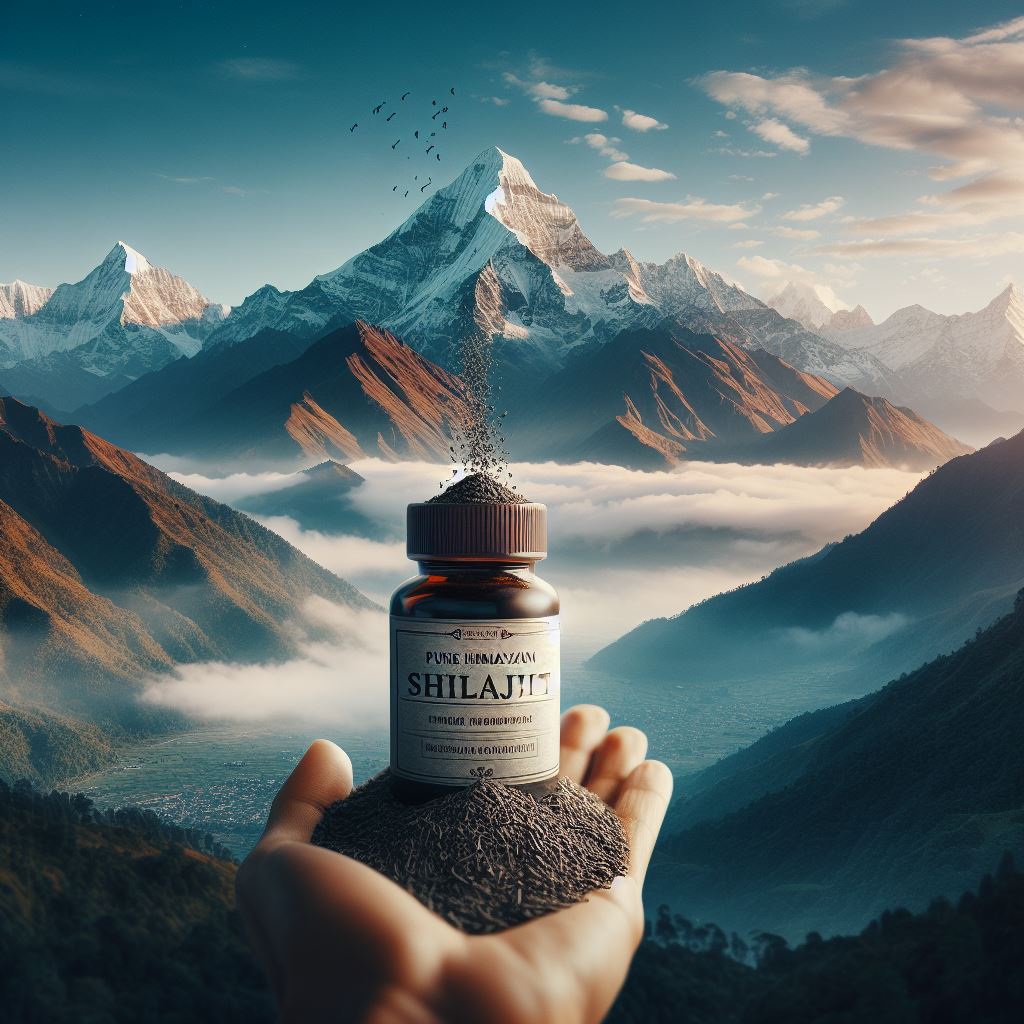

Pure Himalayan Shilajit, a mysterious and ancient substance derived from the heart of the Himalayan Mountains, has captured the attention of health enthusiasts and researchers alike. This thick, blackish-brown, sticky resin, known as “Shilajit,” is not merely a traditional remedy but a reservoir of potential benefits for both the physical body and the mind. In this comprehensive exploration, we delve into the origins, mineral content, and diverse health aspects of this unique herb-mineral supplement.
In the heart of the majestic Himalayas, the fascinating genesis of pure Himalayan Shilajit unfolds as a testament to millions of years of natural alchemy. This extraordinary substance, revered for its therapeutic properties, emerges from the intricate interplay of plants and organic matter ensnared by layers of rocks. The Himalayas, with their extreme weather variations and colossal pressures, serve as the crucible for this mineral-rich marvel. As if orchestrated by nature, the mountains exert immense pressure, compelling Shilajit to flow out, resulting in a unique, sticky, tar-like material. What adds to the mystique of Shilajit’s extraction is the role played by nature’s inhabitants – foot-long scorpions. In specific areas, these creatures contribute to the release of precious Shilajit by engaging in a delicate dance with the rocks, underscoring the intricate and fascinating process through which this remarkable substance finds its way from the heart of the Himalayas to the hands of those seeking its natural benefits.
Within the realm of Shilajit, nature unfolds its diversity through distinctive types, each bearing its unique mineral composition. Shilajit stands are categorized into four main types: Copper (Tamra), Silver (Rajat), Gold (Sauvarna), and Iron (Lauha). These classifications are not merely distinctions but windows into the mineral riches encapsulated within. Iron Shilajit, distinguished by its blackish-brown hue, takes center stage among these varieties, earning recognition for its exceptional healing properties. As we delve into the diverse tapestry of Shilajit types, we embark on a journey through the intricate nuances of nature’s offerings, each type representing a harmonious blend of minerals that contribute to the substance’s multifaceted benefits.
The roots of Shilajit’s prominence delve deep into the history of Himalayan villages, where astute observers witnessed large white monkeys indulging in a mysterious substance atop the lofty mountaintops. This keen observation marked the genesis of a discovery that would weave its way into the tapestry of traditional medicine. As Himalayan villagers incorporated this enigmatic substance into their diets, the transformative effects became apparent – a cascade of improvements in physical and mental health, augmented muscle and bone strength, and the tantalizing prospect of increased longevity. The traditional wisdom surrounding Shilajit as a potent healing agent began to take shape, passed down through generations as a treasured component of holistic well-being. This ancient connection between nature, observation, and the nurturing of health underscores the profound relationship that indigenous communities have cultivated with Shilajit over the ages.
At the core of Shilajit’s allure lies its rich composition, boasting a treasury of over 85 natural ionic minerals, each contributing to its therapeutic potency. Essential elements harmonize within this herbal substance, alongside significant quantities of fulvic acid, humic acid, and vital phytonutrients. Fulvic acid emerges as a linchpin, playing a pivotal role in the absorption of minerals into cellular structures, a process integral to Shilajit’s health benefits. Delving into its preparation, Shilajit undergoes a meticulous purification journey involving filtration and dehydration. Notably, there are two distinct types – Aftabi (sun-dehydrated) and Aatshi or Agni (fire-dehydrated). Ayurvedic wisdom sheds light on the preference for Aftabi Shilajit, underlining its perceived potency over the Agni variant. This nuanced understanding of Shilajit’s composition and processing not only enhances our appreciation for its holistic properties but also provides valuable insights into the traditional practices that have evolved around this exceptional natural remedy.
Shilajit stands as a revered and unifying herbal remedy, earning prestigious titles like the “conqueror of mountains” and the “destroyer of weakness.” Anchored in ancient wisdom, particularly in texts such as Charaka Samhita, Shilajit emerges as a potent elixir with multifaceted healing properties. Ayurvedic practitioners celebrate its role in addressing a diverse spectrum of ailments, showcasing its versatility as a therapeutic agent. From combatting parasites and managing diabetes to alleviating skin diseases and addressing issues of sexual debility, Shilajit is hailed as a comprehensive remedy that harmonizes the body and mind. Its rich history within Ayurvedic traditions adds depth to its reputation, positioning Shilajit as more than just an herbal substance but as a time-honored elixir contributing to holistic well-being.
the ancient science of holistic healing, the classification of herbs involves a nuanced evaluation of their taste (rasa), potency (virya), and post-digestive effect (vipaka). Shilajit, a revered substance in Ayurvedic traditions, presents a distinctive profile in this classification. Its taste profile encompasses a harmonious blend of astringent, pungent, and bitter notes, creating a sensorial symphony on the palate. When we delve into its potency, Shilajit reveals a warm virya, contributing a subtle warmth that aligns with its therapeutic properties. Furthermore, in the realm of post-digestive effects, Shilajit exhibits a pungent vipaka, signifying the enduring essence it imparts after digestion.
This intricate classification system underscores Shilajit’s versatility, indicating its compatibility with the elemental forces known as doshas in Ayurveda. Specifically, its astringent, pungent, and bitter tastes, coupled with a warm virya and pungent vipaka, make Shilajit well-suited for balancing vata and kapha doshas. This elemental harmony aligns with Ayurvedic principles, where balance is the key to overall well-being. As we explore the depths of Ayurveda, Shilajit emerges as a fascinating example of nature’s ability to offer remedies in perfect accord with the intricate balance of our bodily constitution.
Delving into the realm of scientific inquiry, Shilajit emerges as an herbal powerhouse with a myriad of health benefits substantiated by rigorous research. Scientific studies have meticulously explored its antioxidant properties, highlighting its capacity to combat oxidative stress. The anti-inflammatory nature of Shilajit positions it as a potential ally in the body’s battle against inflammation. Its adaptogenic qualities contribute to the body’s ability to adapt and resist stressors, while immunomodulatory effects hint at Shilajit’s role in supporting the immune system. A particularly intriguing finding is its anti-dyslipidemic properties, suggesting potential benefits for cholesterol management. The positive impact on physical performance and the alleviation of fatigue underscore Shilajit’s holistic approach to well-being. Additionally, the substance’s influence on spermatogenesis opens avenues for its application in addressing fertility concerns. Beyond these immediate advantages, the preventive potential against Alzheimer’s disease adds another layer to Shilajit’s versatile profile, offering a promising outlook for both current and future well-being seekers.
Pure Himalayan Shilajit serves as a living testament to the profound wisdom embedded in traditional medicine, harmoniously converging with the insights of modern scientific research. With its intricate mineral composition and distinctive properties, Shilajit emerges as a comprehensive supplement poised to uplift both physical vitality and mental well-being. As we delve into the enigmatic qualities of Shilajit, the trajectory of its promising future in fostering longevity and resilience becomes increasingly apparent. This ancient gift from the Himalayas beckons us to embrace a holistic approach to health, bridging the timeless traditions of herbal wisdom with the validated findings of contemporary science. In this fusion of tradition and scientific exploration, Pure Himalayan Shilajit stands as a beacon, offering a pathway towards a healthier and more robust life.
Discover the transformative power of Shilajit, carefully sourced and curated for your vitality. Embrace a journey of holistic health with nature’s rejuvenating essence. Elevate your well-being with Xomoashro.